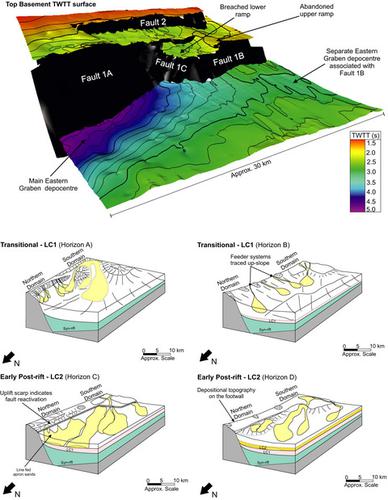当前位置:
X-MOL 学术
›
Basin Res.
›
论文详情
Our official English website, www.x-mol.net, welcomes your
feedback! (Note: you will need to create a separate account there.)
The effect of breached relay ramp structures on deep-lacustrine sedimentary systems
Basin Research ( IF 2.8 ) Pub Date : 2022-01-04 , DOI: 10.1111/bre.12655 Gayle E. Plenderleith 1 , Thomas J.H. Dodd 1 , Dave. J. McCarthy 1
Basin Research ( IF 2.8 ) Pub Date : 2022-01-04 , DOI: 10.1111/bre.12655 Gayle E. Plenderleith 1 , Thomas J.H. Dodd 1 , Dave. J. McCarthy 1
Affiliation

|
Fault relay ramps are important sediment delivery points along rift margins and often provide persistent flow pathways in deepwater sedimentary basins. They form as tilted rock volumes between en-echelon fault segments, which become modified through progressive deformation, and may develop through-going faults that ‘breach’ the relay ramp. It is well established that hinterland drainage (fluvial/alluvial systems) is greatly affected by the presence of relay ramps at basin margins. However, the impact on deepwater (deep-marine/lacustrine) subaqueous sediment gravity flow processes, particularly by breached relay ramps, is less well documented. To better evaluate the complex geology of breached relay settings, this study examines a suite of high-quality subsurface data from the Early Cretaceous deep-lacustrine North Falkland Basin (NFB). The Isobel Embayment breached relay-ramp, an ideal example, formed during the syn-rift and was later covered by a thick transitional and early post-rift succession. Major transitional and early post-rift fan systems are observed to have consistently entered the basin at the breached relay location, directed through a significant palaeo-bathymetric low associated with the lower, abandoned ramp of the structure. More minor systems also entered the basin across the structure-bounding fault to the north. Reactivation of basin-bounding faults is shown by the introduction of new point sources along its extent. This study shows the prolonged influence of margin-located relay ramps on sedimentary systems from syn-rift, transitional and into the early post-rift phase. It suggests that these structures can become reactivated during post-rift times, providing continued control on deposition and sourcing of overlying sedimentary systems. Importantly, breached relays exert control on fan distribution, characterised by laterally extensive lobes sourced by widespread feeder systems, and hanging walls settings by small-scale lobes, with small, often line-sourced feeders. Further characterising the likely sandstone distribution in these structurally complex settings is important as these systems often form attractive hydrocarbon reservoirs.
中文翻译:

破坏接力斜坡结构对深湖沉积系统的影响
断层中继斜坡是沿裂谷边缘的重要沉积物输送点,通常在深水沉积盆地中提供持久的流动通道。它们在梯形断层段之间形成倾斜的岩石体积,通过逐渐变形而改变,并可能发展出“突破”接力坡道的贯穿断层。众所周知,腹地排水系统(河流/冲积系统)受到盆地边缘中继坡道的影响很大。然而,对深水(深海/湖相)水下沉积物重力流动过程的影响,特别是被破坏的中继坡道的影响,却鲜有记载。为了更好地评估破坏中继设置的复杂地质,本研究检查了早白垩世深湖北福克兰盆地 (NFB) 的一套高质量地下数据。Isobel Embayment 突破了中继斜坡,这是一个理想的例子,在同裂谷期间形成,后来被厚厚的过渡和早期裂谷后的演替覆盖。观察到主要的过渡和早期裂谷后风扇系统一直在破坏的中继位置进入盆地,引导通过与较低的废弃结构斜坡相关的重要古深度低点。更多的次要系统也穿过北部的构造边界断层进入盆地。通过沿其范围引入新的点源表明盆地边界断层的重新激活。这项研究表明,位于边缘的中继斜坡对沉积系统从同裂谷、过渡到裂谷后早期阶段的长期影响。这表明这些结构可以在裂谷后重新激活,持续控制上覆沉积系统的沉积和来源。重要的是,被破坏的继电器对风扇分布施加控制,其特点是由广泛的馈线系统提供横向扩展的叶,以及由小规模叶设置的挂墙设置,通常是线源馈线。进一步描述这些结构复杂的环境中可能的砂岩分布是很重要的,因为这些系统通常会形成有吸引力的油气藏。
更新日期:2022-01-04
中文翻译:

破坏接力斜坡结构对深湖沉积系统的影响
断层中继斜坡是沿裂谷边缘的重要沉积物输送点,通常在深水沉积盆地中提供持久的流动通道。它们在梯形断层段之间形成倾斜的岩石体积,通过逐渐变形而改变,并可能发展出“突破”接力坡道的贯穿断层。众所周知,腹地排水系统(河流/冲积系统)受到盆地边缘中继坡道的影响很大。然而,对深水(深海/湖相)水下沉积物重力流动过程的影响,特别是被破坏的中继坡道的影响,却鲜有记载。为了更好地评估破坏中继设置的复杂地质,本研究检查了早白垩世深湖北福克兰盆地 (NFB) 的一套高质量地下数据。Isobel Embayment 突破了中继斜坡,这是一个理想的例子,在同裂谷期间形成,后来被厚厚的过渡和早期裂谷后的演替覆盖。观察到主要的过渡和早期裂谷后风扇系统一直在破坏的中继位置进入盆地,引导通过与较低的废弃结构斜坡相关的重要古深度低点。更多的次要系统也穿过北部的构造边界断层进入盆地。通过沿其范围引入新的点源表明盆地边界断层的重新激活。这项研究表明,位于边缘的中继斜坡对沉积系统从同裂谷、过渡到裂谷后早期阶段的长期影响。这表明这些结构可以在裂谷后重新激活,持续控制上覆沉积系统的沉积和来源。重要的是,被破坏的继电器对风扇分布施加控制,其特点是由广泛的馈线系统提供横向扩展的叶,以及由小规模叶设置的挂墙设置,通常是线源馈线。进一步描述这些结构复杂的环境中可能的砂岩分布是很重要的,因为这些系统通常会形成有吸引力的油气藏。











































 京公网安备 11010802027423号
京公网安备 11010802027423号